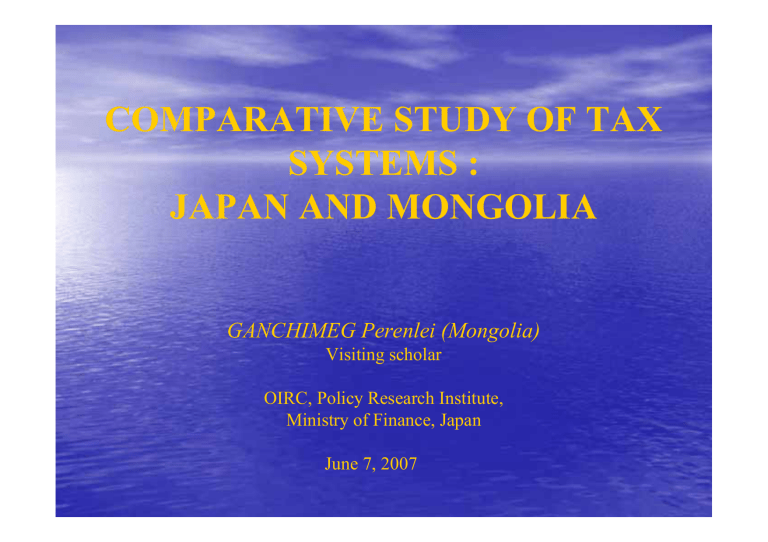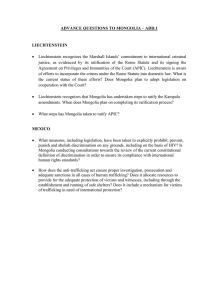Comparative study of tax systems Japan & Mongolia
advertisement

COMPARATIVE STUDY OF TAX SYSTEMS : JAPAN AND MONGOLIA GANCHIMEG Perenlei (Mongolia) Visiting scholar OIRC, Policy Research Institute, Ministry of Finance, Japan June 7, 2007 COMPARATIVE STUDY OF TAX SYSTEMS: JAPAN AND MONGOLIA OUTLINE I. COUNTRY BACKGROUND II. RECENT ECONOMIC DEVELOPMENT III. TAX SYSTEM OF MONGOLIA IV. COMPARISIONS OF TAXES V. LOCAL TAX SYSTEMS AND INTERGOVERNMENTAL FISCAL RELATIONS VI. TAX ADMINISTRATIONS VII. POLICY IMPLICATIONS VIII. CONCLUSION I. COUNTRY BACKGROUND • • • • • • • LOCATION: CENTRAL EAST ASIA AREA: 1.57 MLN SQ KM POPULATION: 2.562 MLN POPULATION DENSITY: 1.6 person per 1 sq km CURRENCY TOGRIG (MNT) 100 ¥ = 983 MNT GDP (current market prices): 2065.0 millions US$ GDP per capita, /2005/: 806 US $ II.RECENT ECONOMIC DEVELOPMENT Real GDP Growth 12% 10% • Favorable weather conditions • 8% 6% 4% 2% 0% 00 001 002 003 004 005 006 0 2 2 2 2 2 2 2 • • • and livestock increase Higher commodity prices in the world market, especially those of gold and copper Mining related foreign direct investment Inflows of worker’s remittance Rapidly developing service sector Composition of GDP, Mongolia (2005) Communication 3.0% Service 13.2% Agriculture 21.3% • Agriculture at its peak in Construc tion 2.6% • nsport 9.7% Trade 24.6% Industry 25.6% 1995, constituted 40% of GDP Changes in economic structure were accompanied by changes in employment and substantial migratory movements from rural to urban areas Trade in goods of Mongolia Main destinations of export 2005: Main destinations of import 2005: -China (48.2%) -Russia (35.3%) -USA -China (25.9%) (14.3%) -Canada (11.4%) -Japan (6.4%) -UK (8.2%) -South Korea (5.4%) -South Korea (6.1%) -Kazakhstan (3.4%) -Russia (2.6) -USA (3.4) Principal exports 2005: Principal imports 2005: -Copper -Petroleum -Textiles -Machinery & equipment -Cashmere & Cashmere products -Transport equipment Fiscal Balance of Mongolia 10 50 9 8 6 40 4 3.2 2 30 0 -2.1 20 -2 -4.2 -4.5 -4 -5.8 10 -6 -7.7 -8 -10 0 2000 20001 Revenue 2002 2003 Expenditure 2004 2005 2006 Government deficit ( in percent of GDP) Main factors of improvement of fiscal balance are: • Jump in Government revenues due to the boom in copper and gold prices • Tighter budgetary controls • Imposition of windfall tax on copper and gold (in June 2006) Revenue development of Mongolia 300.0 / in %, base year-1999 (266.5 billions of MNT)/ 250.0 243.0 200.0 165.6 150.0 97.3% 100.0 79.0% 50.0 31.7% 64.8% 2000 2001 2002 2003 2004 2005 Challenges in the Mongolia’s economy • GDP growth • Public debt became • Narrow base of economy • Heavy dependent on • • • • manageable Improved fiscal and trade balance Inflation remains low Public financial management reform • • • • external market Inadequate infrastructure Poverty Unemployment Urban migration Environmental pollution III. TAX SYSTEM OF MONGOLIA • The tax system of Mongolia consists of 23 taxes, 6 of • • them are state taxes and the others are local taxes. The tax system includes not only taxes, but also fees and payments such as payment for the use of natural resources and license fee for hunting. The most important direct taxes are Corporate Income Tax and Personal Income Tax. The most important indirect taxes are VAT and Excises. Tax burden of Mongolia • Tax burden of the country is Tax ratios 90 70 82.5 81.8 80 74.3 75.3 74.7 76 • 60 50 • 40 30 • 25.6 29.4 28.6 28.8 30.5 30.5 20 • 10 0 2000 2001 2002 Tax/GDP 2003 2004 2005 Tax/Total revenue the highest in Asia Tax revenue became the main source of government’ revenue Among taxes the VAT remains main source of tax revenue Corporate income tax revenue has been increased mainly from mining sector Other taxes such as Royalty payment and license fee have been increased in last 2 years Composition of Mongolia’s Tax Revenue, 2005 Other taxes 13% Income taxes 26% Earmarked taxes 2% Customs 8% Excises 11% SSC 14% VAT 26% Objectives of tax reform • Increase country competitiveness by lowering tax burden on business, enabling job creation • Relief tax burden on workers by reducing the tax rate • Support domestic investors by removing discretionary tax provisions • Simplify tax administration procedures by focusing more on service to tax payers Mongolia’s Recent Tax Reforms 1. 2. 3. 4. 5. 6. Review the existing system of tax incentives Reduce income tax rates Raise the threshold for the higher rate from 100 million MNT to 500million MNT. Remove the limits on legitimate expenses and provide for carrying forward of losses Improve the VAT including its provisions for refunds, cascading under the VAT by providing input tax credits for preproduction expenses and pre-registration stock of goods Make the tax laws simple, clear, consistent and certain IV. COMPARISONS OF TAXES Main development indicators Japan Population (m) Surface area (thousand sq. km) Population density (people per sq.km) Gross National Income ($ billions) GNI per capita ($) GDP growth (%,2003-2004) Value added as % of GDP (2004): -agriculture -Industry -Services Life expectancy: -Male -Female Source: WB. World Development Indicators. 06 128.0 378 351 4,734.3 37050 2.7 1 31 68 78 85 Mongolia 2.6 1567 1.6 1.8 600 10.7 21 30 49 62 68 Comparison of Fiscal Balances (as a percentage of GDP) 1996FY 2000FY 2001FY 2002FY 2003FY 2004FY 2005FY 2006FY -6.8 -8.0 -6.1 -7.7 -7.8 -6.2 -6.1 -5.6 -5.1 -7.5 -6.1 -7.9 -7.7 -6.5 -6.5 -6.0 -12.2 -7.7 -4.5 -5.8 -4.2 -2.1 +3.2 +9.0 Japan Mongolia Note: For Japan, the first row shows the general government balance balance excluding social security funds. Hence, the second row shows the fiscal balance including social security security funds Sources : Current Japanese Fiscal Conditions and Issues to be Considered. Considered. 2006, MOF, Japan . Statistical bulletin, 2005, SSO Mongolia, Budget execution 2006, MOF, Mongolia Composition of Government’ revenue ( as % of GDP) Developing Countries Asia & Pacific Mongolia (2004) High Income Countreis Japan (2004) Total revenue Tax revenue Other revenue 22.1 16.6 37.3 32.8 31.0 17.6 13.2 30.5 27.5 26.4 4.5 4.3 6.8 5.3 4.6 Source: Keen & Simone (2005), OECD Revenue Statistics.1965Statistics.1965-2005, MOF. Mongolia (2005) Breakdown of Revenues (FY 2006) General Account Budget Revenue of Japan (FY 2006) Tax and Stamp revenue 38% 57% 5% General Government Budget Revenue of Mongolia (FY 2006) 0.4% Tax revenue 18.1% Non-Tax revenue Non-Tax revenue 81.4% Government Bond Issues Foreign grants Level of taxation (% of GDP) Fiscal year 1991 1992 1993 1994 1995 1996 1997 1998 1999 2000 2001 2002 2003 2004 Japan* Tax revenue 18.0 16.0 15.6 14.5 14.6 14.6 14.8 14.3 13.9 14.6 14.4 13.3 13.1 13.8 Mongolia Social Security contributions Total 10.7 11.0 11.5 11.8 12.3 12.3 12.4 12.6 12.6 12.5 12.9 12.9 12.6 12.6 28.7 27.0 27.1 26.3 26.9 26.9 27.3 26.9 26.5 27.1 27.3 26.2 25.7 26.4 Tax revenue 27.2 21.6 25.6 18.9 16.3 15.9 17.1 15.7 16.5 21.7 24.6 24.6 24.3 26.2 Social Security contributions Total 1.9 2.9 2.9 2.6 3.2 3.2 3.9 4.8 4.4 4.5 4.3 27.2 21.6 25.6 20.8 19.2 18.8 19.7 18.9 19.7 25.6 29.4 29.0 28.8 30.5 *Source: OECD revenue statistics,1965statistics,1965-2005. Statistical bulletin 1998, 2005, SSO, Mongolia Composition of Taxation: central government revenues, early 2000s, (% of total tax revenues) Developing countries Asia & Pacific Mongolia High Income Countries Japan Taxes on income, profit & capital gains Social security & payroll taxes Domestic taxes on goods & services International trade taxes Property taxes 25.1 35.1 25.8 32.6 26.1 14.4 4.0 22.1 27.9 29.9 39.4 40.5 26.1 33.0 23.1 18.3 15.9 8.2 4.9 1.8 1.4 1.5 0.9 2.5 2.8 Source: Keen & Simone (2005), MOF, Japan (2005), MOF, Mongolia (2005) (2005) Sources of tax revenues of two countries (selected years, %) Year 1997 1998 1999 2000 2001 2002 2003 2004 Japan Direct taxes 63.4 59.3 57.2 61.3 59.5 56.3 56.1 58.2 Mongolia Indirect taxes 36.6 40.7 42.8 38.7 40.5 43.7 43.9 41.8 Direct taxes 51.2 43.9 38.1 39.3 36.6 36.2 39.8 39.8 Indirect taxes 48.8 56.1 61.9 60.7 63.4 63.8 60.2 60.2 Source: OECD Tax Statistics, 1965-2004; MOF, Mongolia 1996-2006 Budget data Composition of Tax Revenues FY2006 General Account Budget, Japan Others 12% FY 2006 General Government Budget, Mongolia Others 8% Income tax 29% Roaylty 6% Corpora tion Tax 20% Liquor 3% Customs 8% Gasoline Tax 5% Personal Income Tax 8% Excises 11% Consumpti on Tax 23% Corpor ate Tax 28% Windfall Tax 14% VAT 25% Main Statutory Tax Rates Japan Mongolia* Individual Income Tax 5,10,20,23,33,40 10 (10,20,30) Corporate Income Tax 22,30 10,25 (15,30) 5 10 (15) VAT Note: In Japan, in addition to Individual Income Tax at national level, inhabitant tax also applied with flat 10% (prefecture level 4% municipality level 6%) flat rate starting from FY 2007 * Numbers in brackets are the tax rates applied until 1 Jan.2007 Individual Income Taxes Japan Mongolia Income tax ratio to GDP(2004) 8.5% 2.4% Income tax ratio to tax revenue (2004) 31.9% 7.8% 5,10,20,23,33,40* 10% 46.14million* 346,700 0.86 million yen 0.89 million yen Tax rates Number of taxpayers Tax burden on individual an annual employment income of 10 million yen Source: OECD revenue statistics.1965-2005. Comprehensive Handbook of Japanese taxes 2006, Tax Bureau, MOF Japan *the new rate structure (national) applied to Income tax from FY 2007 Individual Income Taxes In Japan: In Mongolia: • PIT has a small weight in the tax • Tax base is narrow and yields low revenue despite relatively high statutory rates • Wide brackets and generous allowances • PIT identifies 10 different kinds of income that are taxed at different effective rates • Retirement and capital income are taxed separately at lower rates • Most of tax expenditure in the system arise from the tax credit for individual’s acquisition of dwellings and deduction of contributions to pension plans and life insurance companies revenue • Unifies the tax rate on taxable personal income at 10%, replacing the existing three-tired rate of 10,20 and 30% • Raises the tax credit on taxable personal income from MNT 48,000 a year to 84,000, statutorily exempting from taxes below the poverty line • Permits sole proprietorship operators to deduct more business expenses • Defines fringe benefits and includes them in taxable income Corporate income taxes Japan Mongolia Tax rates 22, 30 10, 25 Ratio to GDP as of 2004 3.8% 5.2% Ratio to national tax revenue 23.8% 16.9% 2.90 million (as of 2003) 32.255 Tax burden 70% of corporations are report making loss. Large companies shoulder 2/3 of CIT revenue. 43% of the companies are 0 or negative net income. Top 100 provided over 90% of CIT revenue Depreciation Straight-line and Declining balance methods Straight-line method 7 years 3 years Number of taxpayers Loss carry forward Main features of the CIT In Japan: Mongolia: • The CIT structure is unique • Second largest revenue source • Effective tax rates have been • Reduces the lower rate from • • • • reducing Two depreciation scheme Tax free reserves (for Bad Debts and for Returned Goods) Preferential tax terms (allowances, credits, etc) Tax credits Privileges under the blue return system • • • • 15% to 10%, and the higher rate from 30% to 15% and raises threshold from MNT 100 million to MNT 500 million Permits business entities to deduct more of their legitimate business expenditures Provides for an investment tax credit Provides for loss-carry forward Eliminates most discriminatory tax exemptions and holidays Tax incentives for corporations In Japan: In Mongolia: • Tax credits to promote policy • The new CIT law abolished objectives such as energy conservation, pollution control, promotion of small to mediumsized businesses and promotion R&D • Special depreciation measures • Tax free reserves • Income deduction • The Blue return system: loss carry back 1 year & loss forward for 5 years provisions on tax holidays and several exemptions • The income tax of companies engaged in manufacturing cereals, potato and vegetables reduced by 50% • tax credit equal to 5% of the total investment made in priority sectors determined by the Government • Loss carry forward for 3 years VAT rates, revenue and efficiency Standard VAT rate Asia average Bangladesh Cambodia China Fiji Indonesia Japan Korea Mongolia Nepal Papua New Guinea Philippines Samoa Singapore Sri Lanka Thailand Vanuatu Vietnam Latin America average CEE average 10.5 15.0 10.0 17.0 12.5 10.0 5.0 10.0 15.0 10.0 10.0 10.0 10.0 4.0 15.0 7.0 12.5 10.0 14.0 20.0 Other VAT rates 13.0 10.0 5.2 Source: IMF Country Report No.05/337, Grandcolas (PFTAC, 2003) VAT revenue/GDP 3.8 4.1 .. 5.6 6.2 3.7 2.0 4.7 7.3 3.0 4.5 3.1 10.7 1.4 5.9 3.1 5.4 4.3 5.9 8.0 Efficiency ratio 0.38 0.27 .. 0.33 0.50 0.37 0.40 0.47 0.49 0.30 0.45 0.31 0.86 0.35 0.39 0.44 0.43 0.43 0.38 0.40 Applicable year 2003 2002 2000 2003 2001 2001 2001 2001 2003 2002 2003 2002 2001 2004 2002 2002 2002 Consumption Tax & VAT Japan (Consumption tax) Mongolia (VAT) Tax rates 5% 10% Threshold Tax base ¥ 10 million Deduction on taxable purchase 10 million MNT~ ¥ 1 million Invoice Non-taxable Export Land transfer or lease, housing lease, interest on loans and insurance premium, medical care, education, welfare service. Financial services, housing lease, medical care, education, religious activities, public transportation, newspaper and some other imported goods. exempt “O” rate Proportion to tax revenue 20.2% 26.1% Ratio to GDP 2.5% 8.0% 2.027 thousand (tax returns in 2002) 6800 (2005) Number of taxpayers Main features of the VAT and consumption tax In Japan: In Mongolia: • • VAT is major source of revenue • VAT is based on tax invoice and input tax credit system • One rate and zero rate on export • Threshold for registration is MNT 10 million, threshold is in lower side to compare with other countries • The VAT law provides a provision on refunds to taxpayers in an excess credit position. • The new law eliminates the majority of the exemptions, however exemptions are still wider than that of Japan. The VAT is unique, and rate is one of the world’s lowest • Single rate and export exempted • Few exempted goods and services • • • No invoices are provided for Tax- exempted sales threshold of ¥10 million A simplified VAT regime exists for small businesses, whose sale is below ¥50 million Other consumption taxes Ratio to total tax revenue Japan Mongolia 15.8% 11.4% Liquor tax Beer(per kl):¥134,250-178,125 Wine (per kl): ¥120,000 Whisky(37%): ¥370,000 Spirits(37%): ¥370,000 Beer(per liter): $ 0.20 Wine (per liter): $0,5- $1.5 Whisky (per liter): $4.5- $6.0 Spirits (per liter): $10.0 Tobacco tax ¥3,552 per 1000 pieces ¥820 per 1000 pieces $0.60 per 100 pieces (~ ¥700 per 1000 pieces) Local taxes on tobacco Prefectural tax: ¥1,074 per 1000 pieces Municipal tax: ¥3,298 per 1000 pieces Gasoline tax ¥48,600 per kilolitre <90 octane: $11.0- $30.0 >90 octane:$12.0- $43.0 Main features of other consumption taxes • In Japan, each commodities are regulated by the separate laws, there is no special law as excise. • In Japan, excises on alcoholic beverages and tobacco have traditionally not been conceived in relation to negative externalities, it is generally accepted that alcohol and tobacco taxes may be justified to control the consumption of items that are considered unhealthy. • Mongolia imposes excise duties on few goods like alcohol and tobacco products, petroleum products and imported passenger vehicles • Starting from 2007, Mongolia imposes excise duties on slop games in the perspective of social justice. • Excise duties are levied basically with the specific rates in $ US • Both national and local gov’s levy • About 70 % of excise duties come from • Most of taxes are earmarked for • The excise tax is solely the national tax commodity taxes. specific purposes and designed as service charges for the use of road, airport, and power plants excises on imported goods. and its proceeds go to the national treasury account. V.LOCAL TAX SYSTEMS AND INTERGOVERNMENTAL FISCAL RELATIONS Mongolia is Unitary state: 18 aimags, 362 soums Intergovernmental fiscal relations in Mongolia Main issues are: • • • • • • The sizes of local governments are small The revenue raising capacity are different among aimags Local governments lacks autonomy & accountability Some of local taxes are still not been implemented Assignment of some taxes are not appropriate The size of funds for transfer not based on stable institutional framework Local taxes in two countries • In Japan, 42.7% of total taxes collected from the local taxes, while local government’ expenditures account about 63% of net national and local expenditure. • In Mongolia, only 6.8 % of taxes collected from the local taxes, local government’ expenditures account only 9.2% of general government current expenditures. • In Japan, main local taxes are the enterprise tax (30% in 2004) in prefectures and the property tax (45.7% in 2004) in municipalities. • In Mongolia, generally main source of local taxes is the land fee (25% in 2004) which is imposed on posses and use of state owned land. Local revenue sources Sources of revenue, Japan Total ¥ Bn % •Local taxes •Local allocation taxes •Local Transfer taxes •Special local grants •National Treasury Disbursement •Local loans (bonds) •Other revenue sources 35548.5 20349.8 624.0 901.8 14433 11816 16330.9 35.5 20.3 0.6 0.9 14.4 11.8 16.3 Total 100,004 100.0 Total Sources of revenue, Mongolia MNT M % •Local taxes •VAT transfer •Non-tax revenue •Other revenue source •National Government 47468.0 11920.5 11580.4 2895.9 5947.9 59.5 14.9 14.5 3.6 7.5 79812.7 100.0 Disbursement Total Source: Ministry of Home Affairs, Japan (2003), Ministry of Finance, Mongolia (2005) VI.TAX ADMINISTRATIONS Japan National tax Tax policy & reform MOF/Tax Bureau Enforcement NTA Customs MOF/Custom s & Tariff Bureau Local tax Social insurance Ministry of Internal Affairs Ministry of H, L,& W Social Insurance Agency Local Gov. Local Gov. Social Insurance Mongolia State tax Customs Local Tax Tax policy & reform MOF/Fiscal policy Department/ Tax policy Division MOF/Fiscal policy Department/ Tax policy Division MOF/Fiscal policy Department/ Tax policy Division Ministry of L &W Enforcement MTA General Customs Department MTA Social insurance agency • In Japan, local tax and social insurance are collected by the local governments. • In Mongolia, state and local tax are collected by the tax authority and social insurance collected separately from the MOF. Main features of two countries’ tax administrations Japan’s Tax Administration: • Self-assessment system • Blue return system • Bookkeeping scheme • The withholding tax Mongolia’s Tax Administration: • Self-assessment system • Presumptive taxation • The withholding tax Efficiency of the tax administrations Number of personnel Japan Mongolia 56315 (end of 2003) 1372 (end of 2005) By type of duty: •Assessment of taxes •Revenue management &collection •General affairs & coordination 68% 15% 17% 83.2% Personnel expenses out of total budget of operating cost 78.7 49.2 2,9 million (2003) 46.14 million 32.3 thousand 346.7 thousand ¥ 1.78 1.51 MNT~¥ 15.0 •Number of corporations •Individual income tax payers Cost of collection * Source: An outline of Japanese tax administration 2003. Budget Framework Framework 20052005-2008 MOF Mongolia Other main features of Japanese tax administration • Public relations & tax education • Tax consultation • Certified Public Tax Accounts • Cooperative private Bodies • Guidance and examination • Revenue management & collection • Effective withholding tax system • Training for the NTA staff • Human resource management Features & challenges of Mongolia’s tax administration • Vertical structure of MTA • The structure of GDNT is a mixture of “division by • • • • • • function” and “division by taxpayer type” Excessive focus on tax collection Compliance rates are low Tax avoidance and evasion appear to be common Motivating and punishing measures are inappropriate Luck of training and education for tax officials and taxpayers Needs more computerization VII. POLICY IMPLICATIONS • Tax reforms and tax policy in Japan considering • • into account the economic conditions of the country Most of tax reforms were successful when a cadre of policymakers and experts have a detailed knowledge with the existing system and take responsibility for the reform In Japan, substantial effort have been made to educate both the tax officers and the public and to get the policy ready to support them Cont-d: • Annual tax reductions played a vital role in • • encouraging private businesses which are closely linked to tax incentives in order to achieve specific policy targets, in particular capital accumulation, saving increases, and export promotion and so on. To introduce of inheritance and gift tax based on Japanese experience To broaden local tax base by implementing local tax reform and introducing the new local taxes such as a city tax. The amount of shared taxes to local governments should be defined in a law and determined according to the law instead of discretionary decision of the central government. Cont-d: • Tax administration should be reformed and • • enhanced to build up fair, transparent, and efficient administration system based on Japan’s tax administration practices Establishment of a “Blue Return” system could be one of the effective measures for preventing tax evasion Establishment of system of Tax accountants based on Japan’s experience VIII.CONCLUSION • Japan is a developed country with comprehensive and complex tax system and with effective Tax Administration • Mongolia is developing country with distorted tax system and inefficient tax administrations • Japanese experience in the area of taxation could serve as a useful reference for Mongolia’s economic development Thank you for your attention


